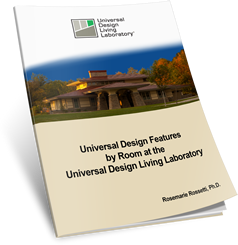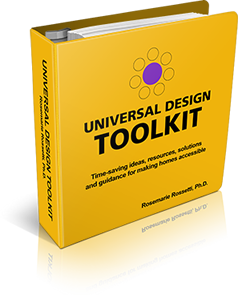
Discover how to live at home more affordably -- with independence, safety and dignity.
Get a sneak-peek at the "Universal Design Toolkit" with this free chapter filled with advice, tips and money-saving resources!

Build your awareness of what universal design features should be incorporated into homes.
Get the newly released "Universal Design Tookit", based on this real life demonstration home.

|
|
Article:
Universally Appealing Home Design for EveryoneRealtor Magazine Online
August 2007
By Barbara Ballinger
Copyright © 2007 Barbara Ballinger
Publication copyright © 2007 THE NATIONAL ASSOCIATION OF REALTORS
|
Curb appeal may get buyers in the door, but a home’s interior design and layout determine how they’ll enjoy the property after they move in. If the buyers — or their close friends or family — have physical disabilities, then special accommodations should be made so they can easily use the home and its amenities.
Some home owners make handicap-friendly modifications after they move in, but more homes are built from the start for owners who plan for the day when they may have bad knees, poor eyesight, or need to use a walker.
This fore-sighted planning goes by the name of universal design. It’s incorrect to think that only baby boomers and seniors are thinking that the idea is smart. While baby boomers certainly are a target market, accidents and physical disabilities can happen at any age, and many younger buyers see the advantage of building a home where they can stay for the long term.
In fact, a whopping 82 percent of U.S. home owners say they want to remain in their homes as they age, even if they require assistance and care, according to a survey by the American Society of Interior Designers.
By expanding your knowledge of universal design, you’ll put yourself ahead of your competition, says Kathy Sperl-Bell, CRS®, SRES®, a salesperson with RE/MAX Realty Group in Lewes, Del., who has built her business around the boomer niche.
The concept of accessible design dates back to World War II, when injured veterans modified their homes to adapt to disabilities, says Richard Duncan, director of Universal Design Training at The Center for Universal Design at North Carolina State University in Raleigh, N.C.
Today the focus is much broader. Its goal is to make places and things easy to use for the widest possible range of people. “Universal design emphasizes the importance of investing in smart designs for a diversity of ability,” says Valerie Fletcher, executive director for Adaptive Environments, a Boston organization that promotes design that works for everyone, from a busy mom with her arms full of groceries to an elderly man who’s recovering from hip surgery.
Universal design features fall within one of these seven guiding principles, according to the Center for Universal Design:
On its Web site, Fletcher’s organization compares universal design to the green building movement: “Universal Design and green design are comfortably two sides of the same coin … Green design focuses on environmental sustainability, universal design on social sustainability.”
Also similar to green construction, universal design has enjoyed an increase in general acceptance recently. Why? In part, because of its good looks. Thanks to architects and designers, universal design features can be “invisible” in a home. A grab bar may resemble a towel bar or chair railing, yet it provides sturdy support for home owners who are shaky on their feet.
Another plus for new-home buyers: It’s roughly a third cheaper to add universal design features during a home’s initial construction than to wait and add them several years down the road as a remodeling project, says Rebecca Stahr, who started an Atlanta consultancy, EasyLiving Home, which offers a Universal Design certification for builders.
There’s no shortage of advocates for universal design. To learn more on the topic, tune in to one of these organizations. All offer plentiful information on the Web.
 Barbara Ballinger is a freelance writer with a passion for architecture and home design.
Barbara Ballinger is a freelance writer with a passion for architecture and home design.